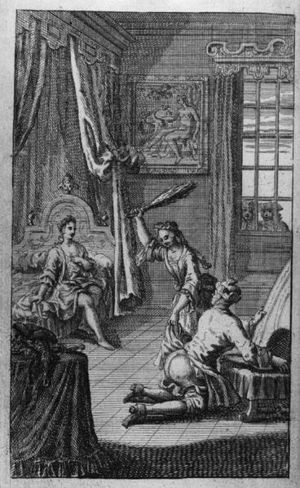Therapeutic spanking
Therapeutic spanking, also known as spanking therapy, is a term used to describe spanking which is given neither primarily for punishment nor for an erotic purpose. Instead, spanking is used as a therapeutic measure for its curative effects.
Therapeutic spanking is usually given in a style that employs the phrases and actions of disciplinary spanking, but in a kind of role playing. It is fully consensual and implemented on the explicit request of a person who feels they need to be spanked.
Individual sessions
A person may wish to be spanked to get rid of guilty feelings for some offense they actually committed but were not (or not sufficiently, in their own feeling) punished for. Such a spanking may follow shortly after the offense, but it is also possible to work up guilty feelings that way that go back years, possibly even to childhood.
In the latter case, the therapeutic spanking may involve ageplay -
Long-term spanking agreements
This approach involves spankings on a more or less regular basis. Typically, a punishment agreement is made between the spankee and the spanker to give spankings either for agreed types of misbehavior which are in the focus of the therapy, or in sessions on a regular basis (such as weekly). It is important to note that therapeutic spanking can be given completely outside any punitive context, for example as a device to help release emotional stress and worries.
The semi-erotic approach
Some adult partners also practice a slightly different sort of therapeutic spanking which is halfway between disciplinary and erotic spanking. This variant is popular as it comes with a double payoff: besides the beneficial effects on the spankee, it also is a very bonding experience between the partners. Its M/F variant is shown in the American sketch comedy series Tracey Takes On... and is described in detail at the Fondly and Firmly domestic discipline website (see the links below).
Medical spanking and whipping
Whipping has long been used as a form of therapy, for example in traditional Buddhist/Tibetian medicine, or Europe from Antiquity up to the 19th century, e.g. for patients who suffered from mental diseases.
In 1629, the German physician Johann Heinrich Meibom wrote De Flagrorum Usu in Re Veneria & Lumborum Renumque Officio about the use of flogging as a sexual stimulant, which became a best seller over the centuries and was translated into many languages, including German, English (On the Use of Rods in Venereal Matters and in the Office of the Loins and Reins)and French.
In 1698, the German medical botanist and poet Kristian Frantz Paullini wrote the book Flagellum Salutis in which he praises flagellation for curative use (e.g. for diseases such as melancholia, paralysis, toothache, sleepwalking, deafness, and nymphomania) as well as for pleasure. Paullini also developed a medical theory on how sexual arousal can come from flagellation (having to do with increased blood flow) which was unchallenged for two centuries until Krafft-Ebing.
The Swedish graphologist Hans Scheike developed a form of spanking therapy in the 1960s.
In 2005, Russian scientists reported that they found "whipping therapy" to be an effective means against alcohol and drug abuse, depression, suicidal thoughts and psychosomatic diseases. The scientists recommend the following course of the whipping therapy: 30 sessions of 60 whip lashes on the buttocks in every session. They explain the results, which they say were "good and excellent", by the body's endorphin mechanism.
In these approaches to therapeutic spanking, there is usually no role play of any kind involved. The whipping or spanking is ideally given in a non-punitive, service-like, medical manner, like a kind of skin treatment, similar to a form of massage. Needless to say, by modern standards such a form of therapy which involves substantial pain must be 100% consensual and never be forced on a patient.
See also
Links
- Spanking Needs "I Need to be Spanked" - Spanking Needs Explained
- Therapeutic Spanking "and how to ask for it" on Fondly and Firmly (M/F)
- Therapeutic Spanking as "a new (old) route to mental health" on Finding Sara (M/F)
- Whipping therapy cures depression and suicide crises (news article)
- Spanking 'brings couples together' (30 March 2009, New Scientist)
- External links & Video for Tracey Takes On...
Chat rooms • What links here • Copyright info • Contact information • Category:Root
